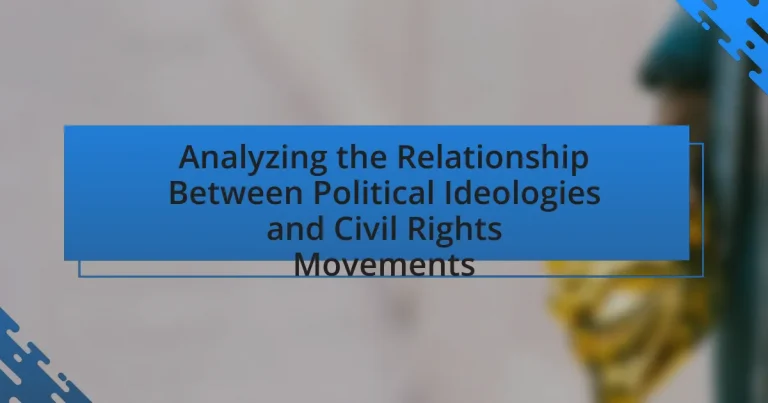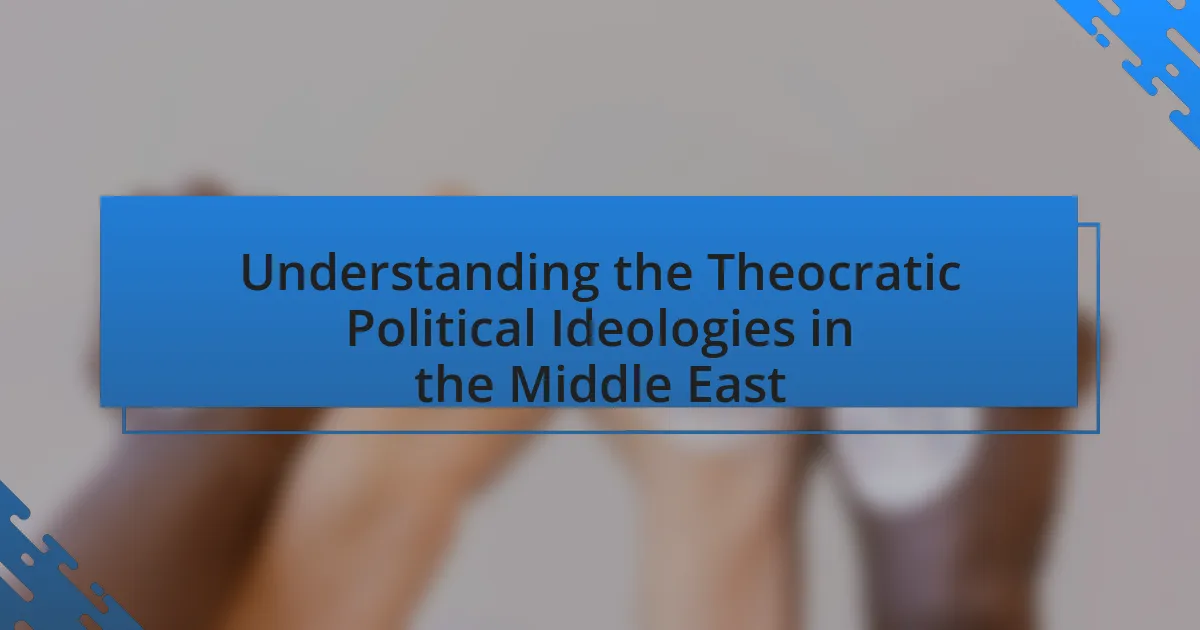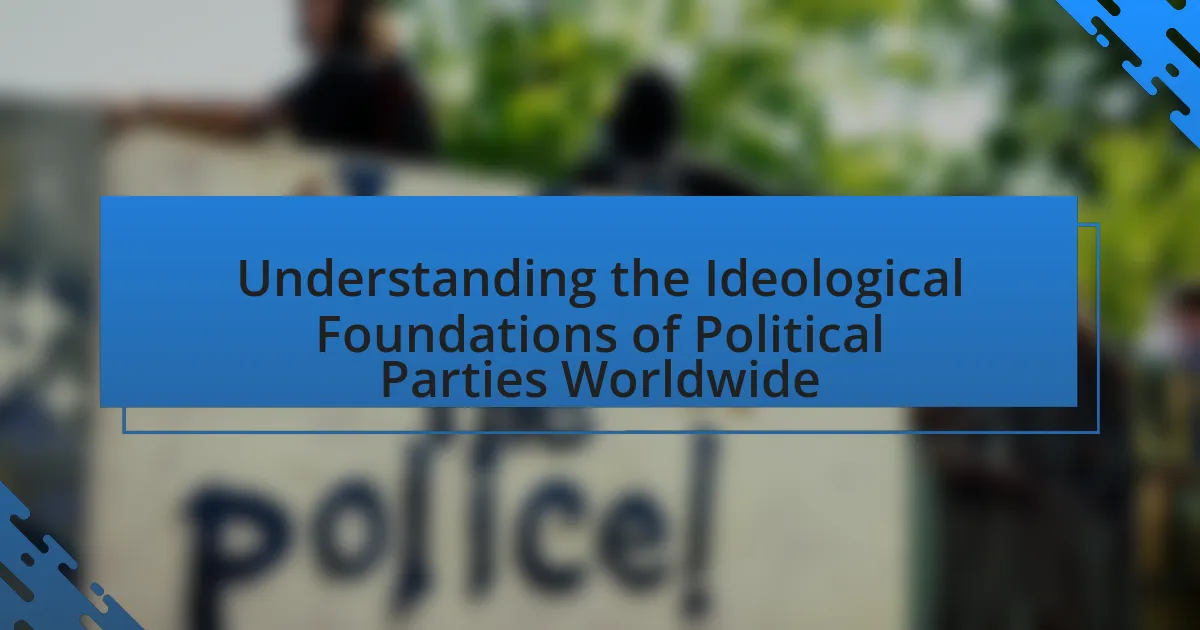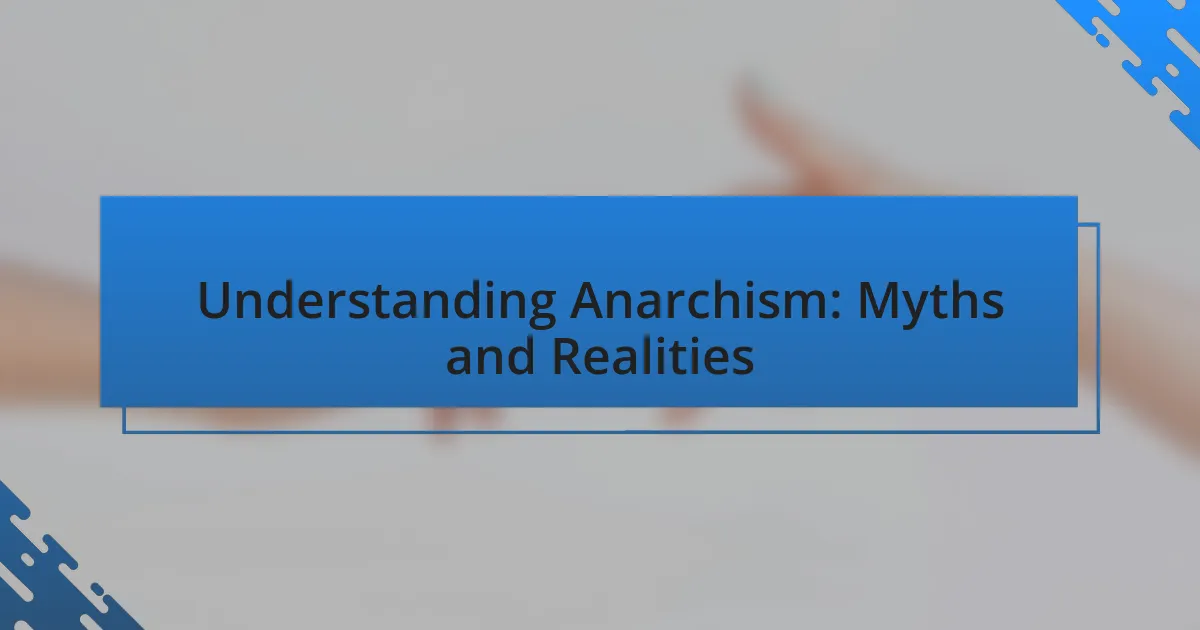The article analyzes the relationship between political ideologies and civil rights movements, highlighting how ideologies such as liberalism, conservatism, and socialism shape the goals, strategies, and public support of these movements. It discusses historical examples, including the Civil Rights Movement in the United States and the anti-apartheid movement in South Africa, illustrating how ideological frameworks influence legislative changes and grassroots activism. The article also examines contemporary movements like Black Lives Matter and rights, emphasizing the impact of progressive and populist ideologies on current civil rights advocacy. Key strategies for effective civil rights movements, including coalition-building and targeted messaging, are also outlined, demonstrating the importance of navigating diverse political perspectives.
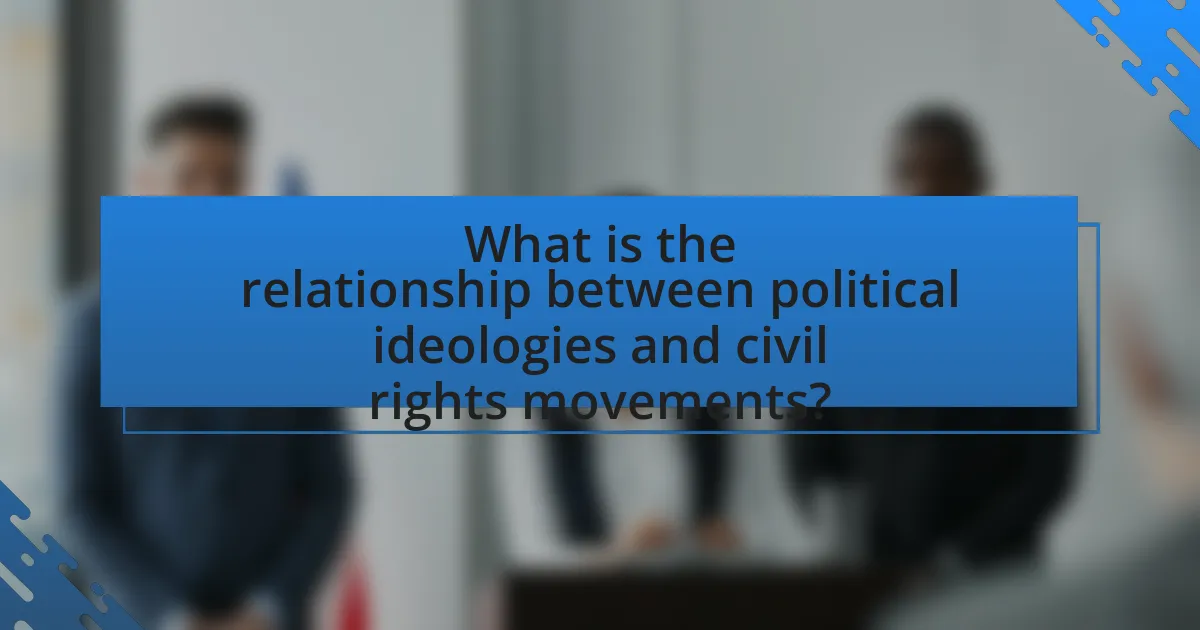
What is the relationship between political ideologies and civil rights movements?
Political ideologies significantly influence civil rights movements by shaping their goals, strategies, and public support. For instance, liberal ideologies often advocate for equality and social justice, which have historically fueled movements such as the Civil Rights Movement in the United States during the 1960s, where activists sought to dismantle racial segregation and discrimination. Conversely, conservative ideologies may prioritize tradition and social order, which can lead to resistance against certain civil rights advancements. The interplay between these ideologies and civil rights movements is evident in legislative changes, public opinion shifts, and the mobilization of grassroots activism, as seen in the rights movement, which gained momentum through liberal advocacy for equal rights and recognition.
How do different political ideologies influence civil rights movements?
Different political ideologies significantly influence civil rights movements by shaping their goals, strategies, and public support. For instance, liberal ideologies often advocate for individual rights and social justice, leading to movements that focus on equality and anti-discrimination laws, as seen in the Civil Rights Movement of the 1960s in the United States, which aimed to end racial segregation and promote voting rights. Conversely, conservative ideologies may prioritize tradition and social order, which can result in resistance to certain civil rights advancements, as observed in opposition to same-sex marriage in various regions. Additionally, socialist ideologies emphasize collective rights and economic equality, influencing movements that seek broader systemic changes, such as labor rights and wealth redistribution, exemplified by the labor movements in the early 20th century. These ideological frameworks not only dictate the objectives of civil rights movements but also affect the level of mobilization and the types of coalitions formed, ultimately impacting the success and direction of these movements.
What are the key political ideologies that shape civil rights movements?
Key political ideologies that shape civil rights movements include liberalism, socialism, and nationalism. Liberalism emphasizes individual rights and freedoms, advocating for equality and justice, which has historically driven movements like the Civil Rights Movement in the United States during the 1960s. Socialism focuses on social ownership and egalitarianism, influencing movements that seek to address systemic inequalities, such as labor rights and anti-racism initiatives. Nationalism can also play a role, as it often seeks to unify a group based on shared identity, leading to movements that fight for the rights of marginalized communities within a nation. These ideologies provide the foundational principles that guide the goals and strategies of civil rights movements, as evidenced by historical examples like the fight against apartheid in South Africa, which was rooted in both liberal and nationalist ideologies.
How do liberal ideologies promote civil rights initiatives?
Liberal ideologies promote civil rights initiatives by advocating for equality, social justice, and individual freedoms. These ideologies emphasize the importance of protecting marginalized groups through legislation and policy reforms, such as the Civil Rights Act of 1964, which aimed to eliminate discrimination based on race, color, religion, sex, or national origin. Additionally, liberal movements often mobilize grassroots activism and support organizations that work towards civil rights, exemplified by the American Civil Liberties Union’s efforts to defend individual rights and liberties. This commitment to inclusivity and justice is rooted in the belief that a fair society benefits all citizens, thereby reinforcing the necessity of civil rights initiatives.
In what ways do conservative ideologies impact civil rights movements?
Conservative ideologies often impact civil rights movements by promoting a focus on individual responsibility and limited government intervention, which can hinder the advancement of collective rights. For instance, conservative arguments against affirmative action emphasize meritocracy, suggesting that such policies undermine individual achievement and create dependency. This perspective can lead to legislative and judicial actions that restrict civil rights protections, as seen in cases like Fisher v. University of Texas, where the Supreme Court upheld limitations on affirmative action in college admissions. Additionally, conservative ideologies may prioritize traditional social values, which can result in opposition to movements advocating for rights, as evidenced by various state-level laws aimed at restricting such rights under the guise of religious freedom.
Why is understanding this relationship important?
Understanding the relationship between political ideologies and civil rights movements is crucial because it reveals how ideological frameworks shape the goals, strategies, and outcomes of these movements. For instance, the civil rights movement in the United States was significantly influenced by liberal ideologies advocating for equality and justice, which helped mobilize support and create legislative changes, such as the Civil Rights Act of 1964. This connection illustrates that political ideologies not only provide the philosophical underpinnings for civil rights advocacy but also impact the effectiveness and direction of these movements, as seen in various historical contexts where ideological shifts led to changes in public policy and societal attitudes.
How does this relationship affect policy-making?
The relationship between political ideologies and civil rights movements significantly influences policy-making by shaping the priorities and frameworks within which laws are developed. For instance, when progressive ideologies align with civil rights movements, policies tend to focus on expanding rights and protections for marginalized groups, as seen in the Civil Rights Act of 1964, which was a direct response to civil rights activism. Conversely, conservative ideologies may prioritize law and order or traditional values, potentially leading to policies that restrict civil rights advancements. This dynamic is evident in the varying state responses to issues like voting rights and police reform, where ideological stances directly impact legislative outcomes.
What implications does it have for social justice?
The implications for social justice in analyzing the relationship between political ideologies and civil rights movements are significant, as political ideologies shape the frameworks within which civil rights are pursued and understood. For instance, liberal ideologies often advocate for individual rights and equality, leading to movements that emphasize anti-discrimination laws and social equity, as seen in the Civil Rights Movement of the 1960s in the United States, which aimed to dismantle systemic racism and promote equal rights for African Americans. Conversely, conservative ideologies may prioritize tradition and social order, potentially resisting changes that promote social justice, as evidenced by opposition to affirmative action policies. This dynamic illustrates how political beliefs can either advance or hinder social justice efforts, influencing legislation, public opinion, and the overall progress of civil rights initiatives.
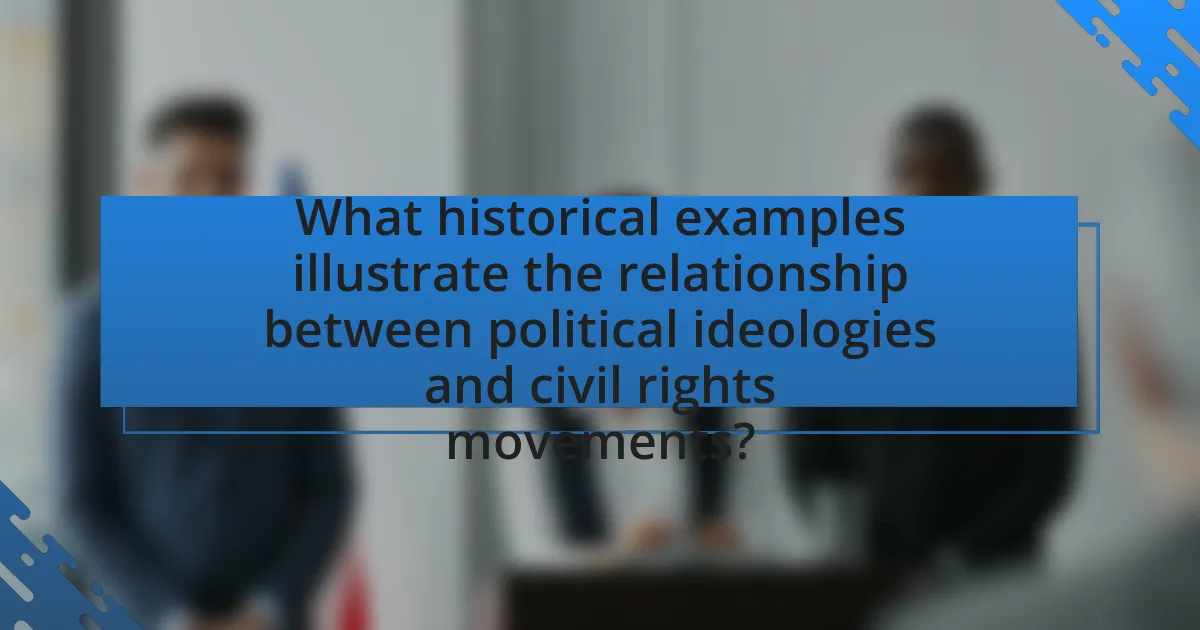
What historical examples illustrate the relationship between political ideologies and civil rights movements?
Historical examples that illustrate the relationship between political ideologies and civil rights movements include the Civil Rights Movement in the United States during the 1950s and 1960s, which was heavily influenced by liberal ideologies advocating for equality and justice. The movement sought to dismantle systemic racism and secure voting rights, culminating in significant legislative achievements such as the Civil Rights Act of 1964 and the Voting Rights Act of 1965. These laws were enacted in response to the demands of civil rights activists who were inspired by liberal principles of democracy and human rights. Another example is the anti-apartheid movement in South Africa, which was driven by a combination of socialist and liberal ideologies that emphasized equality and social justice, leading to the end of apartheid and the establishment of a democratic government in 1994. Both movements demonstrate how political ideologies can shape civil rights agendas and influence societal change.
How did the Civil Rights Movement of the 1960s reflect political ideologies?
The Civil Rights Movement of the 1960s reflected political ideologies by advocating for equality and justice, primarily influenced by liberalism and social democracy. This movement sought to dismantle systemic racism and promote civil liberties, aligning with liberal principles that emphasize individual rights and government responsibility in ensuring social justice. Key events, such as the March on Washington in 1963, where Martin Luther King Jr. delivered his “I Have a Dream” speech, highlighted the demand for civil rights as a moral imperative rooted in democratic ideals. Additionally, the passage of the Civil Rights Act of 1964 and the Voting Rights Act of 1965 showcased the political commitment to addressing racial discrimination, reinforcing the ideological belief that government intervention is necessary to rectify social injustices.
What role did liberalism play in the successes of the Civil Rights Movement?
Liberalism played a crucial role in the successes of the Civil Rights Movement by advocating for individual rights, equality, and social justice. This ideology provided a framework that supported legal and legislative changes, such as the Civil Rights Act of 1964 and the Voting Rights Act of 1965, which dismantled institutional racism and discrimination. Prominent liberal figures, including President Lyndon B. Johnson, championed these laws, emphasizing the need for government intervention to ensure civil rights for all citizens. Additionally, liberal organizations and activists mobilized public opinion and resources, fostering a national dialogue on racial equality and justice, which was essential for the movement’s achievements.
How did conservative resistance shape the movement’s challenges?
Conservative resistance significantly shaped the challenges faced by civil rights movements by mobilizing opposition to progressive reforms and legislation. This resistance often manifested through political lobbying, legal challenges, and grassroots campaigns aimed at preserving the status quo, which impeded the advancement of civil rights initiatives. For instance, during the Civil Rights Movement of the 1960s, conservative groups actively opposed the Civil Rights Act of 1964 and the Voting Rights Act of 1965, arguing that such legislation infringed upon states’ rights and individual freedoms. This opposition not only delayed the implementation of critical reforms but also created a polarized political environment that complicated coalition-building among various advocacy groups.
What lessons can be learned from past civil rights movements?
Past civil rights movements teach the importance of grassroots organizing and coalition-building. For instance, the Civil Rights Movement in the United States during the 1950s and 1960s successfully mobilized diverse groups, including African Americans, labor unions, and religious organizations, to advocate for racial equality. This collective action was pivotal in achieving landmark legislation, such as the Civil Rights Act of 1964 and the Voting Rights Act of 1965, which dismantled institutionalized segregation and protected voting rights. Additionally, these movements highlight the necessity of strategic nonviolent protest, as exemplified by Martin Luther King Jr.’s philosophy, which effectively garnered public support and drew national attention to injustices.
How can these lessons inform current civil rights efforts?
Lessons from historical civil rights movements can inform current civil rights efforts by highlighting the importance of coalition-building and strategic advocacy. For instance, the Civil Rights Movement of the 1960s demonstrated that diverse groups, including African Americans, labor unions, and religious organizations, could unite to challenge systemic racism effectively. This coalition approach led to significant legislative changes, such as the Civil Rights Act of 1964 and the Voting Rights Act of 1965, which serve as models for contemporary movements seeking to address issues like racial inequality and social justice. Additionally, the use of nonviolent protest, as exemplified by figures like Martin Luther King Jr., remains a powerful tactic that current activists can adopt to garner public support and influence policy change.
What are the recurring themes in the relationship between ideologies and movements?
Recurring themes in the relationship between ideologies and movements include the influence of ideological frameworks on mobilization, the role of collective identity, and the impact of socio-political contexts. Ideologies provide the foundational beliefs that shape the goals and strategies of movements, as seen in the civil rights movement, where principles of equality and justice were rooted in liberal and democratic ideologies. Collective identity fosters solidarity among participants, enabling movements to unify diverse groups under a common cause, exemplified by the rights movement, which draws on shared experiences of marginalization. Additionally, socio-political contexts, such as economic conditions and governmental responses, significantly affect the emergence and evolution of movements, as demonstrated during the labor movement in the early 20th century, where economic hardship galvanized collective action. These themes illustrate the dynamic interplay between ideologies and movements, shaping their trajectories and outcomes.
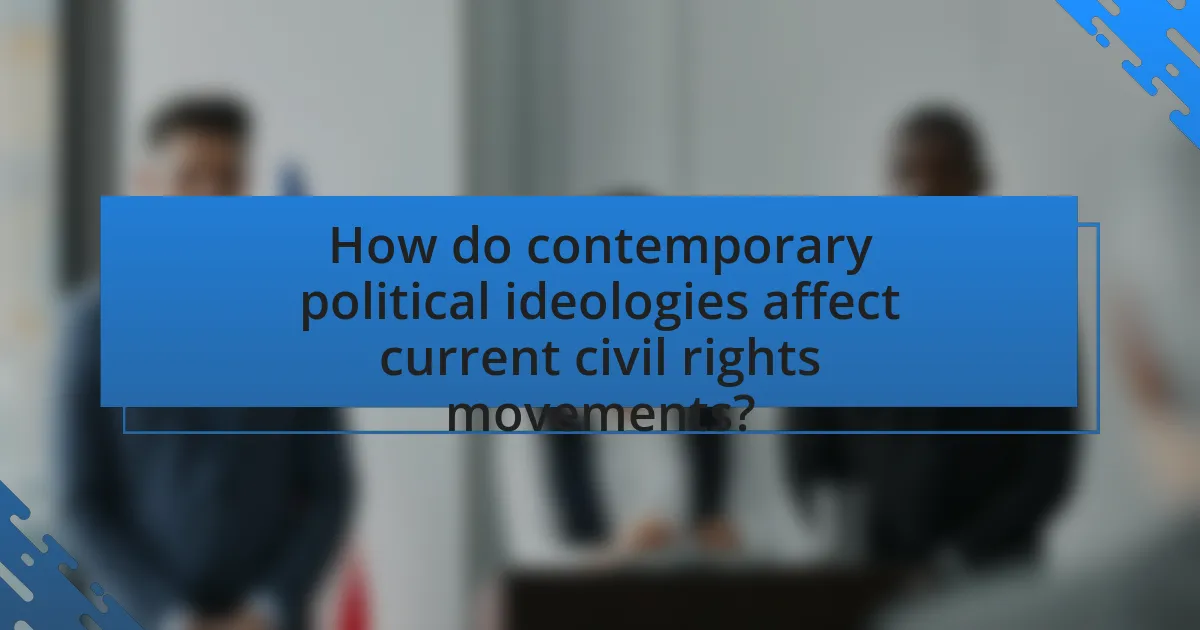
How do contemporary political ideologies affect current civil rights movements?
Contemporary political ideologies significantly shape current civil rights movements by influencing their goals, strategies, and public support. For instance, progressive ideologies often prioritize social justice, leading movements to focus on issues like racial equality, rights, and environmental justice, as seen in the Black Lives Matter movement, which gained momentum in response to systemic racism and police violence. Conversely, conservative ideologies may emphasize individual liberties and limited government intervention, which can lead to resistance against certain civil rights advancements, such as those advocating for expanded healthcare access or affirmative action. The polarization of political beliefs also affects public discourse, with movements often aligning themselves with specific political parties to gain traction, as evidenced by the alignment of many civil rights organizations with the Democratic Party in the United States. This ideological alignment can either enhance visibility and support for civil rights issues or create backlash from opposing political factions, demonstrating the complex interplay between political ideologies and civil rights movements.
What are the current civil rights movements influenced by political ideologies?
Current civil rights movements influenced by political ideologies include the Black Lives Matter movement, which is rooted in anti-racism and social justice ideologies, advocating against systemic racism and police violence. Additionally, the rights movement, influenced by progressive and liberal ideologies, seeks to achieve equality and acceptance for sexual and gender minorities. The environmental justice movement, which intersects with civil rights, is driven by ideologies that emphasize the importance of addressing environmental issues through a lens of equity and justice for marginalized communities. Each of these movements reflects specific political ideologies that shape their goals and strategies, demonstrating the significant impact of political thought on civil rights advocacy.
How do progressive ideologies shape modern civil rights activism?
Progressive ideologies shape modern civil rights activism by promoting social justice, equality, and inclusivity, which are central tenets of contemporary movements. These ideologies advocate for systemic change to address issues such as racial discrimination, gender inequality, and rights, influencing the strategies and goals of activists. For instance, the Black Lives Matter movement, rooted in progressive principles, emphasizes the need for police reform and racial equity, reflecting a broader commitment to dismantling oppressive structures. Additionally, progressive ideologies encourage intersectionality, recognizing how various forms of discrimination overlap, which has led to more comprehensive approaches in civil rights activism. This alignment with progressive values is evident in legislative efforts, such as the Equality Act, which seeks to expand protections for marginalized groups, demonstrating the tangible impact of these ideologies on policy and societal change.
What impact do populist ideologies have on civil rights today?
Populist ideologies significantly impact civil rights today by often prioritizing the interests of a perceived majority over marginalized groups. This prioritization can lead to the erosion of protections for minorities, as populist leaders may promote policies that restrict immigration, limit rights, or undermine racial equality. For instance, research by the Pew Research Center indicates that populist movements frequently exploit societal divisions, which can result in increased discrimination and reduced support for civil rights legislation. Additionally, populist rhetoric often frames civil rights as a zero-sum game, where the advancement of one group is seen as a threat to another, further complicating the landscape of civil rights advocacy.
What strategies can civil rights movements adopt to navigate political ideologies?
Civil rights movements can adopt strategies such as coalition-building, framing issues in a bipartisan context, and leveraging grassroots mobilization to navigate political ideologies. Coalition-building allows movements to unite diverse groups, enhancing their influence and reach across ideological lines, as seen in the Civil Rights Movement of the 1960s, which included various religious, racial, and political organizations. Framing issues in a bipartisan context helps to appeal to a broader audience, making civil rights a shared concern rather than a partisan issue; for example, the Americans with Disabilities Act of 1990 received support from both major political parties. Grassroots mobilization empowers individuals to advocate for their rights, creating a strong base that can pressure political leaders regardless of their ideological stance, evidenced by the Women’s March in 2017, which drew millions across the political spectrum.
How can movements effectively engage with diverse political perspectives?
Movements can effectively engage with diverse political perspectives by fostering inclusive dialogue and collaboration. This approach allows movements to understand varying viewpoints, which can lead to broader support and more comprehensive solutions. For instance, the Civil Rights Movement in the United States successfully engaged with different political ideologies by forming coalitions with labor unions and religious organizations, thereby amplifying their message and reaching a wider audience. Research indicates that inclusive strategies, such as community forums and participatory decision-making, enhance the legitimacy and effectiveness of movements by ensuring that multiple voices are heard and considered.
What best practices can enhance the effectiveness of civil rights advocacy?
Effective civil rights advocacy can be enhanced through strategic coalition-building, targeted messaging, and data-driven approaches. Coalition-building fosters unity among diverse groups, amplifying voices and resources, as seen in the Civil Rights Movement of the 1960s, where alliances between various organizations led to significant legislative changes. Targeted messaging ensures that advocacy efforts resonate with specific audiences, utilizing social media platforms to engage younger demographics, which has proven effective in recent movements like Black Lives Matter. Data-driven approaches, such as employing statistics to highlight disparities and injustices, can strengthen arguments and mobilize support, as evidenced by the use of empirical research in campaigns for voting rights and police reform.
